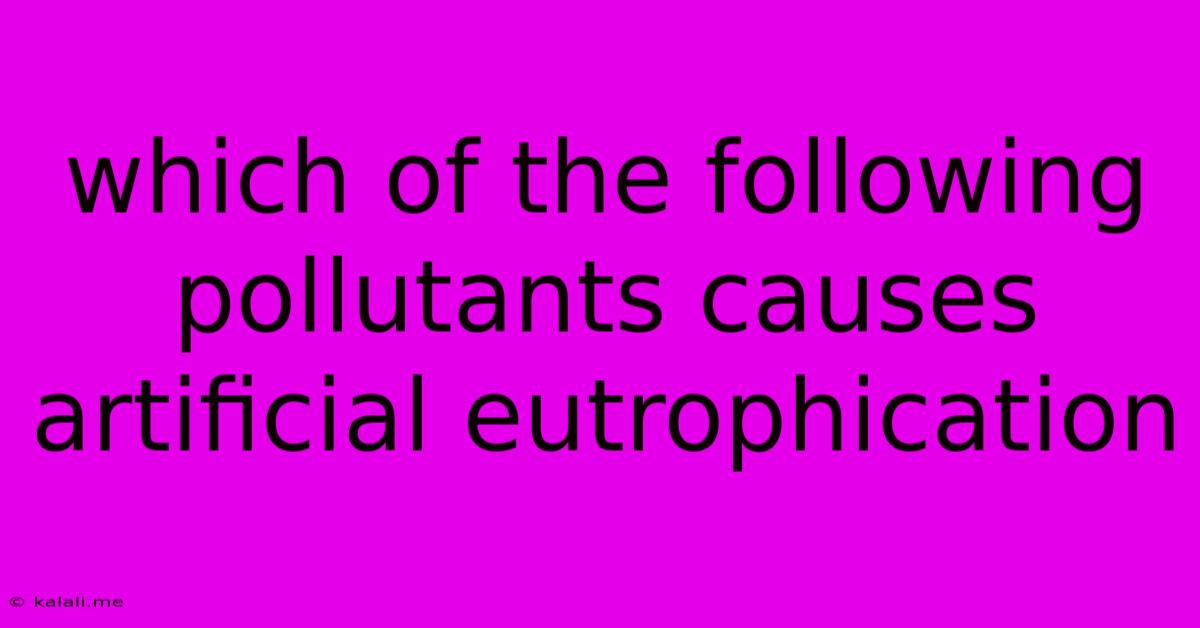Which Of The Following Pollutants Causes Artificial Eutrophication
Kalali
Jun 15, 2025 · 3 min read

Table of Contents
Which Pollutant Causes Artificial Eutrophication? Understanding Nutrient Pollution
Artificial eutrophication, the accelerated enrichment of water bodies with nutrients, is a significant environmental problem leading to harmful algal blooms, oxygen depletion, and the death of aquatic life. But what exactly causes this damaging process? The primary culprit is nutrient pollution, specifically an overabundance of phosphorus and nitrogen. This article will delve deeper into the role of these pollutants in triggering artificial eutrophication.
While other pollutants can contribute to water quality issues, phosphorus and nitrogen are the key players driving artificial eutrophication. Let's examine each one in detail:
Phosphorus: The Limiting Factor
Phosphorus is often considered the limiting nutrient in many aquatic ecosystems. This means that even if other nutrients are abundant, a lack of phosphorus can restrict the growth of algae and other aquatic plants. However, when phosphorus levels rise dramatically – due to human activities – it breaks this natural balance.
Sources of phosphorus contributing to artificial eutrophication include:
- Agricultural runoff: Fertilizers containing phosphorus are a major source. Rain washes these fertilizers from fields into nearby waterways, causing significant nutrient enrichment. This includes both inorganic phosphates and organic phosphorus compounds.
- Wastewater treatment plant effluent: While treatment plants remove a significant amount of phosphorus, some inevitably remains in the discharged water. Improvements in wastewater treatment technology are crucial in reducing this contribution.
- Industrial discharges: Certain industrial processes release phosphorus-containing compounds into water bodies.
- Detergents (historically): Older detergents contained significant amounts of phosphates. While regulations have largely phased out phosphate-based detergents in many areas, they remain a potential source in some regions.
- Erosion: Soil erosion from agricultural lands and construction sites can transport phosphorus-rich sediment into waterways.
Nitrogen: The Fuel for Algal Growth
Nitrogen, while often plentiful in nature, also plays a crucial role in eutrophication. In combination with phosphorus, nitrogen fuels the explosive growth of algae and other aquatic plants.
The major sources of nitrogen contributing to artificial eutrophication include:
- Agricultural runoff: Similar to phosphorus, nitrogen-based fertilizers are a major source of pollution from agricultural activities. These fertilizers, often in the form of nitrates and ammonium, contribute significantly to nutrient overload.
- Wastewater treatment plant effluent: Wastewater contains significant amounts of nitrogen from human waste and other sources.
- Atmospheric deposition: Nitrogen oxides from vehicle emissions and industrial processes can be deposited into water bodies through rainfall, contributing to nitrogen enrichment.
- Animal waste: Runoff from livestock operations can contain high levels of nitrogen, significantly impacting nearby water bodies.
The Synergistic Effect of Phosphorus and Nitrogen
It's crucial to understand that phosphorus and nitrogen don't act independently. They have a synergistic effect, meaning their combined impact is greater than the sum of their individual effects. The presence of high levels of both nutrients creates ideal conditions for rapid algal growth, leading to the devastating consequences of eutrophication.
Conclusion: Combating Artificial Eutrophication
Addressing artificial eutrophication requires a multi-pronged approach focusing on reducing nutrient pollution at its source. This includes improving agricultural practices to minimize fertilizer runoff, upgrading wastewater treatment facilities, stricter regulations on industrial discharges, and promoting sustainable land management practices. By tackling the root causes – primarily phosphorus and nitrogen pollution – we can work towards protecting our valuable water resources and the aquatic life they support. Understanding the specific roles of these pollutants is critical in developing effective strategies for mitigation and prevention.
Latest Posts
Latest Posts
-
Distinguish Between Sampling And Non Sampling Errors
Jun 15, 2025
-
Which Of The Following Contains Both Ionic And Covalent Bonding
Jun 15, 2025
-
Consider The Parallel Plate Capacitor Shown In The Figure
Jun 15, 2025
-
Factors Of 225 That Add Up To 30
Jun 15, 2025
-
Bond Order Formula For Resonance Structures
Jun 15, 2025
Related Post
Thank you for visiting our website which covers about Which Of The Following Pollutants Causes Artificial Eutrophication . We hope the information provided has been useful to you. Feel free to contact us if you have any questions or need further assistance. See you next time and don't miss to bookmark.